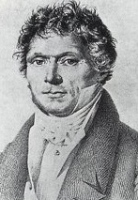Presents
Anton Reicha
 |
 |
Quatuor Scientifique-(A Scientific Quartet)-New Edition
On the manuscript held in the Bibliotheque National in Paris, we find in Reicha's handwriting the words "Quatuor Scientifique consistant en XII morceaux de musique pour deuz violons, alto et violoncelle." (a scientific quartet consisting of 12 movements for 2 violins, viola and violoncello). A scientific quartet--why you ask. The answer lies in the fact that Reicha was a pioneer, in some respects a musical renegade, even more ahead of his time than Beethoven. Famous for singlehandedly creating the wind quintet, the rest of his compositional legacy has been largely overlooked. Reicha was especially interested in modernizing Baroque forms, especially the fugue. After an extended study of the fugues of Bach, Fux, Albrechtsberger, Handel and others, Reicha decided to create a new kind of fugue. And in 1803, he published his 36 Fugues pour le pianoforte composées d'aprés un nouveau système. In the second edition of 1805, Reicha provided notes which explained his thinking but the use of polytonality and structure baffled contemporaries including Beethoven who wrote to his publisher "Such fugues are no fugues." Not long after the second edition of the second edition, Reicha began work on his scientific quartet. With regard to fugues, Reicha believed that the key signature was more important than melodic themes and that any melody could be used.
Quatuor Scientifique dates from 1806. It lay moldering in the National Library in Paris until the late 20th century when it was finally published. This in and of itself explains why Reicha never received the credit he deserved for his efforts in this area. Of the 12 movements, there are 8 new style fugues. Three are from his 36 Fugues for piano and two are on themes by Mozart and Haydn. The first movement, marked La Pantomime Introduction, is not a fugue. Reicha had written a separate piece by the same name, much longer and probably intended as the first movement of a full string quartet. Here, he shortened it and rewrote part of it. It alternaties between a somber Adagio and a lively Allegro. The 8th movement is a lively Allegro assai. The 10th movement is a new style Menuetto and the 12th movement, the finale, is an Allegro poco vivo.
Anton Reicha, (1770-1836, Antonin Rejcha in the Czech form) was born in Prague. Orphaned at an early age, he went to Bavaria and was adopted by his uncle, Joseph Reicha, a concert cellist and music director. He studied violin, flute, piano and composition while with his uncle. In 1785, his family moved to Bonn, where Joseph became music director at the electoral court. There, Anton got to know Beethoven with whom he became life-long friends. He traveled extensively. After living in Paris and Hamburg, in 1801 he moved to Vienna where he studied with Albrechtsberger and Salieri and resumed his friendship with Beethoven and Haydn. In 1806, in part because of the Napoleonic invasion of Vienna, he decided to move to Paris where he spent the rest of his life, eventually becoming a naturalized French citizen. He became a professor at the Paris Conservatory and was one of the most famous teachers of his time. George Onslow, Louise Farrenc, Franz Liszt, Hector Berlioz, Cesar Franck and Charles Gounod were among his many students. He also gained fame as a theorist. He was an innovator in many areas. Though perhaps not the inventor of the Wind Quintet, he was the first to popularize it. A prolific composer, he wrote in virtually every genre. Chamber music is a very important part of his oeuvre. He was always interested in experimenting and in many respects was way ahead of his time dabbling with polytonality and quarter tones. He wrote that he felt the most creative when he experimented trying new things rather than following traditional forms.
This is an extraordinary work by any standard. Not only is this an historically important work by a composer who was in the vanguard of musical thought but because it is a highly interesting work on its own. Our new edition is based on the manuscript in the Bibliotheque National of Paris.
Parts: $29.95
Parts & Score: $49.95